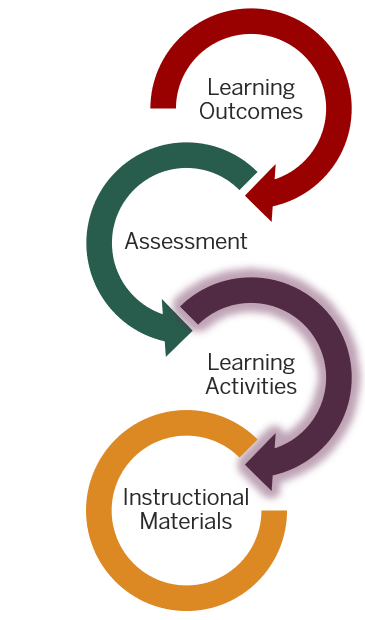Part 4: Learning Activities and Engagement
Learning Activities and Active Learning Online
Listen to this page read aloud

Active interaction is at the heart of the teaching and learning process.
While passive activities, such as reading a text or listening to a lecture are technically learning activities, active learning activities are more effective in helping students learn and develop. If students are actively involved in working with the content, research has shown that they learn more, are more satisfied, and are more successful in the course.
It’s fairly easy to spot active learning in an in-person classroom. In most in-person courses, students complete activities designed to help them learn material and develop competencies or skills. For example. students working together in pairs or small groups to solve problems, answer questions, or brainstorm ideas are active learning. So is classroom discussion where the whole class is engaged in dialogue with each other and the instructor.
Some types of note-taking, like Cornell notes, are also active learning. Classroom assessment techniques (Angelo and Cross, 1993 ), which are small formative assessments done in a few minutes in class, are also examples of interacting with the content. Out-of-class activities – a.k.a homework – normally have students actively work with course concepts, individually or in groups.
The question is, how does this all look online.
Active learning online
Just because your course is all, or predominantly, asynchronous doesn’t mean it can’t be active. Interaction doesn’t have to occur in real-time.
To start out, let’s take a look at the three main types of interaction: student-instructor, student-student, and student-content interaction.
Click on each heading below to learn more.
It’s helpful to think through the balance of interaction over the entire course. Particularly, providing activities that offer a range of student-student interaction (from substantial to moderate to light to none) allows students with different preferences for the amount of peer interaction to be comfortable at some points and challenged to expand their comfort zone at others.
Providing “hands-on” activities for students, either individually or in small groups, is an important way to increase motivation and support learning. For more ideas for online activities, see a Toolkit of Active Learning Options for online teaching and learning from the Active Learning in Higher Education Journal.
Connecting and reflecting
Active learning is more than just “doing things.” Fink (2005), (of the Taxonomy of Significant Learning from Module 1) suggests thinking about active learning as a combination of
- doing things (or observing others doing things),
- connecting it with other information and ideas, and
- reflecting on what it means.
Parts 2 and 3 are important aspects of learning as, without making connections and understanding how what they have learned fits in with the other things they already know, the learning is disconnected and likely to soon be forgotten. Just because they do a thing, doesn’t mean they understand it’s purpose and meaning. This circles back to the TILT model and the importance of including the Purpose in your assignment instructions. Helping your students explicitly see how this new information fits within the topic or discipline can improve retention as it contextualizes it as part of a larger whole.
You can ask students to contextualize content or concepts and reflect on their meaning individually in a learning journal or blog or a series of minute papers. They could also work with a peer in a think-pair-share activity or a synchronous or asynchronous video or audio debrief or with a small group in a discussion or by generating a collaborative mindmap or outline for example.
Another way to do this is by using thinking routines. Having students verbalize and share their understanding can turn up misconceptions that may be hindering their learning without them being consciously aware of it. Like a formative assessment, you can use this information to revisit things that appear to be challenging for multiple students. The following short video from MIT’s Project Zero describes thinking routines and their use.
A thinking routine such as:
- Connect: How are these ideas and information CONNECTED to what you already knew?
- Extend: What new ideas did you get that EXTENDED or pushed your thinking in new directions?
- Challenge: What is still CHALLENGING or confusing for you? What questions or puzzles do you now have?
can be a useful end-of module reflection prompt—done individually, in pairs, or in small groups. It can also be useful to you, as it will show what students think they are learning and what is still confusing. Reflective thinking routines can be ungraded or they can be marked complete/incomplete and count toward participation or as a substitute for attendance.
Participants interact with the course and each other at different times. For example, someone posts in a discussion and someone else can reply minutes or hours later.

